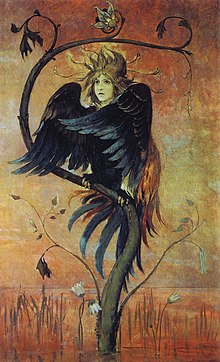You can help expand this article with text translated from the corresponding article in Russian. (November 2022)Click [show] for important translation instructions.
|
This article includes a list of general references, but it lacks sufficient corresponding inline citations .(November 2016) |

Gamayun (Russian : Гамаю́н) is a prophetic bird of Russian folklore. [1] It is a symbol of wisdom and knowledge and lives on an island in the mythical east, close to paradise.[ citation needed ] She is said to spread divine messages and prophecies, as she knows everything of all creation, gods, heroes, and man. Like the Sirin and the Alkonost, other creatures likewise deriving ultimately from the Greek myths and siren mythology, [2] the Gamayun is normally depicted as a large bird with a woman's head.[ citation needed ] In the books of the 17th-19th centuries, Gamayun was described as a legless and wingless bird, ever-flying with the help of a tail, foreshadowing the death of statesmen by her fall.
Gamayun is on the Coat of arms of Smolensk. [3]